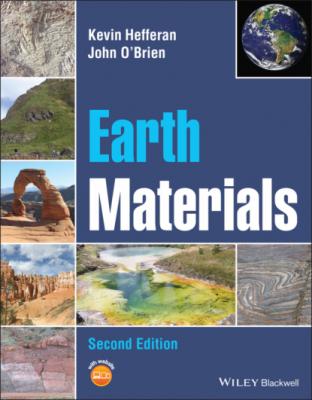Earth Materials. John O'Brien
Читать онлайн.| Название | Earth Materials |
|---|---|
| Автор произведения | John O'Brien |
| Жанр | География |
| Серия | |
| Издательство | География |
| Год выпуска | 0 |
| isbn | 9781119512219 |
25 Nelson, P.L. and Grand, S.P. (2018). Lower‐mantle plume beneath the Yellowstone hot spot revealed by core waves. Nature Geoscience 11: 280–284.
26 Nolet, S.‐I., Karato, S.I., and Montelli, R. (2006). Plume fluxes from seismic tomography. Earth and Planetary Science Letters 248: 685–699.
27 O'Neil, J., Carlson, R.W., Francis, D., and Stevenson, R.K. (2008). Neodynium‐142 evidence for Hadean mafic crust. Science 321: 1828–1831.
28 Ringwood, A.E. (1975). Composition and Petrology of the Earth's Mantle. New York: McGraw‐Hill 618 pp.
29 Sanni, T., Luttinen, A.V., Heinonen, J.S., and Jamai, D.L. (2019). Luehna picrites, Central Mozambique, messengers from a mantle plume source of Karoo continental flood basalts. Lithos: 346–347.
30 Sheridan, R. (1987). Pulsation tectonics as the control of long‐term stratigraphic cycles. Paleoceanography 2: 97–118.
31 Stern, R.A. and Bleeker, W. (1998). Age of the world's oldest rocks refined using Canada's SHRIMP: the Acasta Gneiss Complex, Northwest Territories, Canada. Geoscience Canada 25: 27–31.
32 Tarduno, J., Bunge, H.P., Sleep, N., and Hansen, U. (2009). The bent Hawaiian–Emperor hotspot track: inheriting the mantle wind. Science 324: 50–53.
33 Torsvik, T., Doubrovine, P.V., Steinberger, B. et al. (2017). Pacific plate motion change caused the Hawaiian‐Emperor Bend. Nature Communications 8 https://doi.org/10.1038/ncomms15660.
34 Tschauner, O., Ma, C., Beckett, J.R. et al. (2014). Discovery of bridgmanite, the most abundant mineral in Earth, in a shocked meteorite. Science 346: 1100–1102.
35 Valley, J.W., Cavosie, A.J., Ushikubo, T. et al. (2014). Hadean age for a post‐magma‐ocean zircon confirmed by atom probe tomography. Nature Geoscience 7: 219–223.
36 Vine, F.J. and Matthews, D.H. (1963). Magnetic anomalies over ocean ridges. Nature 199: 947–949.
37 Wang, T., Song, X., and Han, H.X. (2015). Equatorial anisotropy in the inner part of Earth's core from autocorrelation of earthquake coda. Naure Geoscience 3: 224–227.
38 Wang, C., Gordon, R.C., and Zhang, T. (2017). Bounds of geologically current rates of motion of groups of hot spots. Geophysical Research Letters 44: 6048–6056.
39 Wilde, S., Valley, J.W., Peck, W.H., and Graham, C.M. (2001). Evidence from detrital zircons for the existence of continental crust and ocean on the Earth 4.4Ga ago. Nature 409: 175–178.
40 Williams, Q. and Garnero, E.J. (1996). Seismic evidence for partial melt at the base of Earth's mantle. Science 273: 1528–1530.
41 Wilson, J.T. (1963). Evidence from islands on the spreading of ocean floors. Nature 197: 536–538.
42 Wilson, J.T. (1965). A new class of faults and their bearing on continental drift. Nature 207: 343–347.
Chapter 2 Atoms, elements, bonds, and coordination polyhedra
4 2.4 Pauling's rules and coordination polyhedra
5 2.5 The chemical classification of minerals
If we zoom in on any portion of Earth, we will see that it is composed of progressively smaller entities. At very high magnification, we will be able to discern very small particles called atoms. Almost all Earth materials are composed of atoms which, in turn, strongly influence their material properties. Understanding the ways in which these basic chemical constituents combine to produce larger scale Earth materials is essential to understanding our planet.
In this chapter we will consider the fundamental chemical constituents that bond together to produce Earth materials such as minerals and rocks. We will discuss the nuclear and electron configurations of atoms and then discuss the role these play in determining both atomic and mineral properties and the conditions under which minerals form. This information will provide a basis for understanding how and why minerals, rocks and other Earth materials have the following characteristics:
1 They possess specific properties that characterize and distinguish them.
2 They provide benefits and hazards through their production, refinement and use.
3 They form in response to particular sets of environmental conditions and processes.
4 They record information about the conditions and processes that produce them.
5 They permit us to infer significant events in Earth's history.
2.1 ATOMS
Earth materials are composed of smaller entities. At very small scales, such as viewed through a tunneling electron microscope, we are able to discern particles called atoms whose effective diameters are a few angstroms (1 Å = 10−10 m, about a million times smaller than the width of a human hair). These tiny atoms, in turn, consist of three main particles – electrons, protons, and neutrons – which were discovered between 1895 and 1902. The major properties of electrons, protons, and neutrons are summarized in Table 2.1.
Protons (p+) and neutrons (n0) each have a mass of ~1 atomic mass unit (amu) and are clustered together in a small, positively charged, central region of the atom called the nucleus (Figure 2.1). Protons possess a positive electric charge and neutrons are electrically neutral. The nucleus is surrounded by a vastly larger, mostly “empty”, region called the electron cloud. The electron cloud represents the area in which the electrons (e−) in the atom move about the nucleus in patterns called orbitals (Figure 2.1). Electrons have a negative electric charge and an almost negligible mass of 0.000 005 amu. Knowledge of these three fundamental particles in atoms is essential to understanding how minerals and other materials form, how they can be used as resources and how we can deal with their hazardous effects that can be seen occasionally.
Table 2.1 Major properties of electrons, protons, and neutrons.
| Particle type | Electric charge | Atomic mass (amu)a |
|---|---|---|
| Proton (p+) | +1 | 1.00 728 |
| Neutron (n0) | 0 | 1.00 867 |
| Electron (e−) | −1 | 0.0 000 054 |
a amu = atomic mass unit = 1/12 mass of an average carbon atom.
